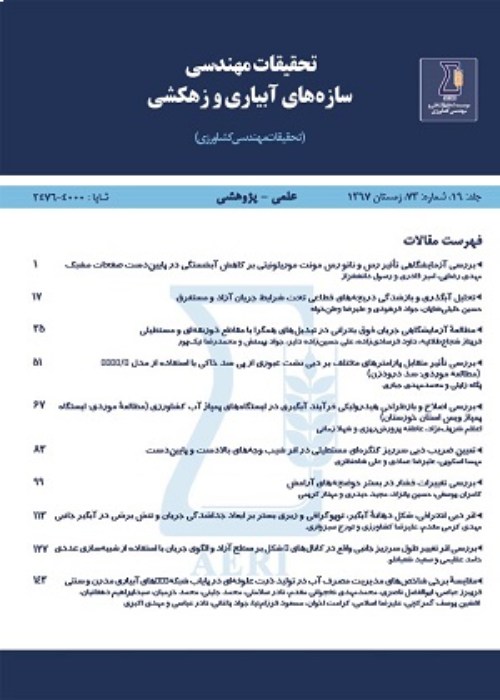Experimental Study of Effect of Sidewall Angle and Weir Height on Total Head and Discharge Coefficient in Trapezoidal Piano Key Weir
The simplest form of non-linear weirs, the labyrinth weirs enjoy a high foot width as a disadvantage. A recently welcome type of the weirs, the piano key weir (PKW) possesses smaller foot width thanks to having ramps, overhangs, and parallel sidewalls (Crookstoon et al., 2018). Several investigations were carried out on the performance of a PKW. Surveying on PKW with Wi/Wo=1.2, Anderson and Tullis (2013) got the fact that applying total head (Ht) in the equation of Lamperier (2009) estimates the discharge higher by 10.1% on average and by 10.9% at most. In addition to the study of physical models, the 3D numerical simulation was done on PKW by Lefebvre et al. (2014) and Pralong et al. (2011b) yielding the results conforming with the experimental data. Most of the hitherto conducted researches were focused on RPKWs with few attention paid on the hydraulic of TPKWs. In this research, the impact of increase in the key angle and the weir's height in TPKWs on the total upstream head and on Cd were investigated. Also, the results obtained with reference to this type of weir were compared to the rectangular type as well as the recent works in the literature.
Laboratory Model The experiments were conducted in the flume of hydraulic laboratory of Water and Power Organization of Khuzestan. The flume was of 7m length, 0.6m width, and 0.5m height. Five models were employed for the experiments in the free-flow condition. These include RPKW and TPKW with sidewalls making angles 4º, 8º, 12º, and 14º with the flow direction. Experiment Process Following the installment of one of the models in the flume, the flow was regulated with a certain discharge by means of a pump and a triangular weir. After the flow was stabilized, the water level at the upstream together with the water head on the weir (H) was taken. Then, the total head (Ht) and discharge coefficient were computed through the following: Where, Ht (m) designates the total upstream head at the upstream, H (m) stands for the piezometric head relative to the weir elevation, and Vu (m/s) is the flow velocity at the upstream.
The relation between the ratio Ht/p < /em> and Cd is illustrated in Figure (1) for all the models used in this research. The maximum amount of the coefficient Cd for RPKWs and TPKWs with key angles 4º, 8º, 12º, and 14º were attained, respectively as 0.54, 0.58, 0.56, 0.611, and 0.59. This guarantees that the maximum discharge coefficient belongs to TPKW with sidewall angle 12º. The figure also substantiates that Cd takes less values in RPKWs respective to TPKWs, a fact agreeing with the findings of Safarzadeh and Noroozi (2014). Figure (2) draws the curve of Ht/p < /em> against Cd for three height ratios P/Wu. As observed, for all the ratios, first the Cd value grows and reaches its maximum, and then decreases. The decrease in Cd values occurs also along with an increase in the ratio P/Wu. The differences among the values of Cd in various ratios of P/Wu broaden as the ratio Ht/p < /em> increases. So, there is a reverse relationship between Cd and P/Wu.
In this research, the discharge coefficient and the total heads of trapezoidal and rectangular piano key weirs were studied and compared. Three cycles, total crest length of 1.65 m, the ratio Wi/Wo=1, and three height ratios 0.75, 0.875, and 1 were adopted for the key piano weirs. The sidewall angles of the key for the trapezoidal piano key weirs were selected as 4º, 8º, 12º, and 14º. The most important results obtained were as follows:- In a certain discharge, the total upstream head of TPKW is less than that of the rectangular counterpart.- The discharge coefficient value in TPKW is greater than in RPKW. - The highest discharge coefficient 0.611 corresponded to the 12 º piano key weir. - The Lampiere's equation (2009) provides an acceptable solution for type A and in particular situations. - An increase in P/Wu leads to a decrease in discharge coefficient value.- The maximum discharge capacity of the 12 º TPKW is 2.35 times that of ogee weir, and it is 2.8 times that of the linear sharp-crested weir.
- حق عضویت دریافتی صرف حمایت از نشریات عضو و نگهداری، تکمیل و توسعه مگیران میشود.
- پرداخت حق اشتراک و دانلود مقالات اجازه بازنشر آن در سایر رسانههای چاپی و دیجیتال را به کاربر نمیدهد.


